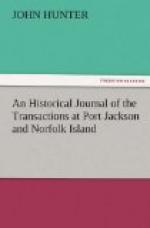The form of the island is a crescent, and it is very small in proportion to the two stupendous rocky mountains which rise at its southern extremity. One of the rocks rises perpendicularly from the sea, and has the appearance of a regular pyramid, when seen from the westward: we sailed from it in a direct course 22 leagues, and could then see it very plainly. Lieutenant Ball, who was certainly the discoverer of this island, has named its points and rocks, as they are marked in the chart*. At noon on the 20th, we lost fight of Ball’s pyramid in the haze, after having run 22 leagues from it in the direction of east by south: I think, in clear weather, it may be seen at the distance of thirty leagues. We had light winds and pleasant weather until the 24th, when we had very strong gales from east-south-east, with a high cross sea.
[* For this Chart, and a View of Ball’s Pyramid, with a full Description, see Phillip’s Voyage, 4to. Edition.]
Early in the morning of the 28th, the wind veered to south-west, and, imagining ourselves to be about fifteen leagues to the westward of Norfolk-Island, we hove to at seven in the evening. The next morning, at day-light, we made sail, steering east: we had great numbers of birds round us, and the clouds hanging very thick to the eastward, indicated our being near the land; but it was not till eleven o’clock in the forenoon that we made the largest of the two small islands which lie off the south-west end of Norfolk-Island, bearing east 16 deg. north, five leagues distant.
At noon, the body of Norfolk-Island bore north 61 deg. east, distant seven or eight leagues. At four in the afternoon, we rounded the northern point of the island, which I named Point Howe, in honour of the first lord of the admiralty, at the time we left England: we soon after hove to, off a cascade, which is situated near the middle of the north side of the island: the boat was hoisted out, and lieutenant Ball and myself went to examine if it were possible to land on a stony beach, which is situated a little to the eastward of the cascade; but we found so great a surf rolling on the shore, that the loss of the boat, and perhaps of the sailors lives, would have been the consequence of our attempting to land; so that at sun-set we returned on board, and the boat was hoisted in.
Early the next morning, lieutenant Ball and myself went in a boat to examine whether we could find a landing-place from the southermost, or Point Ross, to the north-west, or Point Howe, which was (the wind being then west-north-west,) the lee side of the island. From the cascade to a small bay, which lies on the north-east side of the island, we found the shore lined with steep inaccessible cliffs, against which the sea broke with great violence, and rendered the boat’s approach impracticable. The small bay, which I named Ball-bay, (after lieutenant Henry Lidgbird Ball) lies in a west-north-west, and east-south-east direction, and is about four cables length deep, and two cables length wide: the bottom of the bay is a stony beach, on which the surf broke with too much force to risque the boat; though at times, the surf probably may be less.




